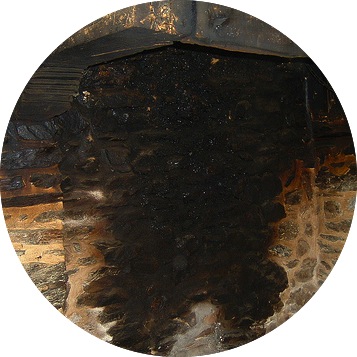Blasting your way to discovering the secrets of old French houses
 When we bought our first house in France it had the lovely old oak beams I’d always dreamed of; however, they were covered in nearly two centuries worth of soot and grime. I spent hours trying to scrub them clean with detergent, washing soda and finally oxalic acid solution.
When we bought our first house in France it had the lovely old oak beams I’d always dreamed of; however, they were covered in nearly two centuries worth of soot and grime. I spent hours trying to scrub them clean with detergent, washing soda and finally oxalic acid solution.
As you can imagine, it’s a messy arm and back-breaking job. I got through buckets and buckets of water, lots of which ran down my up-stretched arm, but they still didn’t seem much cleaner. I accidentally kicked over a bucket of the acid solution and stained the newly laid terracotta tiled floor. There were the shutters to strip with paint stripper – oh the smell and the burns on my poor hands even with gloves on.
If only I’d known about Julie and Graham and the wonders of sandblasting I could have saved myself hours and hours of work, dirt and discomfort. It’s not actually sand that they use, it’s kiln dried crushed granite, there’s no water involved and all the mess is removed at the end of the process.
Julie and Graham Kirkham came to France in 1999; back in the UK, Graham had worked for a family-run engineering company in Hampshire. They came to Brittany in search of a better lifestyle, a country house which they could not have afforded back in Britain and for the warmer winters and longer summers.
Since then they have worked on hundreds of buildings, from small longères to huge manoirs, including many historically important and valuable buildings like watermills and grain mills. Now they work with local registered artisans who recognise their expertise and call them in when their skills are required.
They have also have built a reputation for reliability so that homeowners, both French and British, commission them to work on their houses.
Part of the excitement for Graham and Julie of working on really old buildings and removing the layers of dirt and detritus of centuries is the things they uncover.
“…I like to go to bed hearing owls and wake up looking at fields! No houses, no people just nature. Money can’t buy any better for me.”
Julie says they’ve frequently uncovered carved faces staring back at them from ancient stone walls. Sometimes, when stripping back paint on old fireplaces, they’ve come across writing, which usually means a recycled tombstone complete with skull and crossbones and the names and dates of death of the deceased.
Julie told me, “Once I was up a ladder at a house in the Morbihan and found a line of human bones sticking out of the wall just under the roof level.”
“That’s grand-mère,” said the French owner – I hope he was joking!

Less fascinating and scarier, they found a cache of hand grenades behind the purlins in the grenier of an old house near Quistinic plus a load of bayoneted rifles in the thatched roof, left behind by resistance fighters in the last war. The house owner had to call the gendarmes to come and take them away.
There was the huge hibernating snake which fell down a chimney of a house in Côtes d’Armor while Julie was cleaning: “I don’t know which of us was more surprised.”
They have also come across some pretty eccentric people with equally eccentric ideas about how they’re going making a living in France, but I couldn’t persuade them to open that particular can of worms in case those concerned recognize themselves.
They also have to deal with Bâtiments de France, the French body that is supposed to ensure that protected buildings are restored sympathetically. I know that they can sometimes be very exacting, so I asked Graham and Julie if relations were sometimes strained.
“No, not at all,” they said, “because we are trusted and respected by local architects and we’re present at all meetings where sandblasting is to be done on a protected building. I discuss the requirements with the representative from Bâtiments de France and find out what kind of finish they want to see so no errors occur. I show them photographs of ‘before’ and ‘after’ and the different degrees of cleaning.”
Lastly, I wondered if working on all these grand historic buildings made them wish for a lottery win to buy something similar for themselves.
Julie said, “If, or should I say when – I’m determined and confident that one day I will win the lottery – I would keep my house here. It’s safe to lock up if we want to travel, unlike most properties in England. I genuinely love where I live, we are quite remote here, I like to go to bed hearing owls and wake up looking at fields! No houses, no people just nature. Money can’t buy any better for me.”
What would you do if you went to France and bought one of those old French houses?
All images © Wendy Wise







